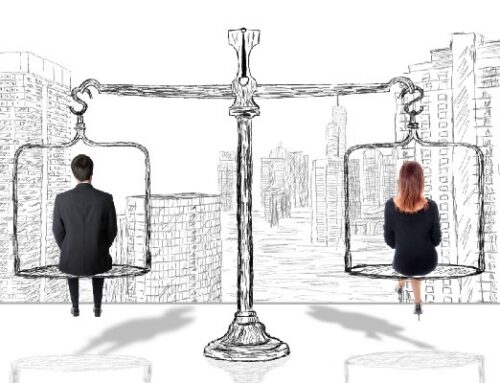Unconscious bias affects every area of our lives. Unconsciously, we tend to like people who look like us, think and act like us and come from backgrounds similar to ours. Everyone likes to think he or she is open-minded and objective, but research has shown that the beliefs and values gained from family, culture and a lifetime of experiences heavily influence how we view and evaluate both others and ourselves.
These thought patterns, assumptions and interpretations – or biases – we have built up over time help us to process information quickly and efficiently. From a survival standpoint, bias is a positive and necessary trait. In business and life, however, bias can be costly. It can cause us to make decisions that are not objective, and ultimately we miss opportunities.
What is Bias?
A tendency to believe that some people and ideas are better than others based on individuals personal and cultural assumptions and preconceived beliefs — wreaks havoc in the workplace. It keeps women and people of minority groups out of the boardrooms, makes it difficult for Baby Boomers to get jobs, limits opportunities, prevents organisations from the true monetary benefits of a diverse workforce, and more. While it’s easy to identify and limit bias when it’s overt, that’s not always the case—in fact, bias can often be completely unconscious.
Even those with the best intentions behave in biased ways and simply have no idea they’re doing it. Most of us use biased language without giving it a second thought.
The Problem with Unconscious Bias
“Okay you guys; it’s time to get down to work,” Jordan says to her team. “Man, this is really going to be a challenge,” Luke replies, exasperated. “Oh boy, here we go, another late night at the office,” Sarah sighs loudly.
This conversation seems like a typical team exchange about a big project, right? Well, it is —and it drives me insane. Why? Because of the language used: “you guys,” “man,” “oh boy.” This is a mixed-gender team, yet the pronouns and expressions are entirely male.
It’s true that male pronouns are traditionally used to represent all members of a group regardless of gender. However, defaulting to what’s “traditional” is very tricky. One could argue that traditionally, women didn’t really have a voice in society anyway, or that traditionally, women were not leaders in businesses. The problem with “traditions” is they can be safe-havens for unconscious bias.
When language promotes bias, the impact is bigger than you might expect: it expresses an inherent belief that male teams are better. Or worse, that women don’t even belong on a team at all. The language may appear neutral or non-sexist, in that it applies to everyone, but it discriminates against women because it reflects the values of the men who created or developed the workplace. Another poignant example is the expression, “Are you man enough for the job?” Even if sayings like this are meant to be harmless, they contribute to many of the challenges women face in the workplace. For example, consider this: How often do you assume the CEO of a company is male?
It’s not only men and women that are guilty of this, the Oxford Dictionary is also an offender. Anthropologist and Ph.D. student Michael Oman-Reagan identified the following biased definitions (and more) in the Oxford Dictionary:
However, gender-biased language isn’t all we’re guilty of. I hear age-biased language about millennials all the time. For example, “I just hired a new kid.” The hire is most likely a “recent graduate” or “young person” which are better terms to use than a kid.
I even saw generational bias in a recent article: “…many kids admitted into top schools are emotional wrecks.” If this is the language we use to describe young people, then our words subconsciously allow us to treat them like children, which partly explains why Gen Y feels like no one takes them seriously. Is this really how we want to treat the second biggest generation, who happens to have the most educated people in its cohort?
Even at companies like Google, whose employees are 70 percent male, 3 percent Hispanic and only 2 percent Black look to unconscious bias, or hidden bias, as a way to explain their inequitable diversity statistics. How else could such a well-educated, well-intentioned company account for hiring mostly young white and Asian men?
The good news is that unconscious bias hiding in plain sight works in management’s favour, because the concept is relatively blameless. If we all have hidden biases, then working to eliminate them won’t single us out—hopefully increasing employees’ and leadership’s willingness to learn.
Here are seven tips for managing unconscious bias that you can use for yourself, your team and your company’s leadership.
“Remember: No one is immune to unconscious bias and all initiatives should be company-wide.”
1) Take an Implicit Associations Test
A good place to start is with an Implicit Associations Test (IAT), developed by Tony Greenwald, a University of Washington professor who started researching unconscious bias in 1994. The test takes five minutes and cuts through the perceptions of our own biases on gender, religion, race, sexuality and more. Prepare test takers for the fact that about 75 percent of people who have taken the race IAT show biases.
2) Watch Your Language
That brings me to an important question: Are leaders giving enough thought to the language they use daily? I’m not talking about overtly offensive language or ethnic slurs. I’m talking about the subtle language we say on autopilot, the type of language that comes from—and worse, reinforces—unconscious, biased behaviour.
My challenge for all of you is to eliminate these biased words from your vocabulary. Avoid words or phrases like: “the kid,” “oh man” or “oh brother,” “manpower,” “you guys,” “attendees and their wives,” etc. These phrases are biased and feed the subconscious biases of those around you. Below are alternative words to add to your vocabulary instead:
- “You guys”: Instead use “everyone,” “all of you,” “team”
- “The kid”: Instead use “the young person,” “young lady,” “young man”
- “Oh man” or “Oh brother”: Instead use “wow,” “ugh,” “yikes
- “Attendees and their wives are invited”: Instead use, “Attendees and their guests…”
- “Congressman”: Instead use “Member of Congress,” “legislator,” “representative”
- “Mankind”: Instead use “humankind,” “humans,” “people”
- “Manpower”: Instead use “personnel,” “staff”
- “Salesman”: Instead use “salesperson”
Seems simple enough, doesn’t it? After you start with the eight words above, you’ll begin to notice how much this language is used on a daily basis. All it takes is practice and awareness to help lower the burden of bias on the women and young people around you. Remember: language creates action and action becomes accepted behaviour which informs organisational culture. Your language, and your actions, matter.
3) Identify Entry Points for Bias
Start by taking a look at these four things:
- How people are hired
- How work is assigned
- What happens during performance evaluations
- How compensation is determined
Where does bias have the opportunity to influence each process? For example, when looking at how people are hired, you may notice that 70 percent of people interviewed are men and white. You could then strip names and other identifying aspects from resumes before review to see if those statistics improve. This tactic is referred to as the interruption strategy. In addition, you could ensure the interview panels are more diverse—for example, when one gender has more decision making power than another, it perpetuates gender bias. People tend to hire and promote people who look like them. As a result, minorities are still largely underrepresented in the workforce.
4) Visualise a Positive Interaction
Psychological research shows that visualising a particular situation can create the same effects behaviourally and psychologically as actually experiencing the situation. In addition, brain studies reveal that mental imagery impacts several cognitive processes in the brain, including attention, perceptions, planning and memory. This means you can train your brain for action through visualisation.
What should you visualise? You can imagine yourself in a positive and productive meeting with team members who are of different ethnicity, generation or gender from you.
5) Encourage Workers to Hold Each Other Accountable
Part of making a concerted effort to eliminate prevailing bias is working together. This is especially key when it comes to hidden bias. Awareness is the first step to enacting any sort of change, so help those on your team be more aware of their behaviours so they are able to self-correct. This goes for management and leadership, too. All major organizational changes need to have complete buy-in and support from leaders.
Biases come in all forms. There are biases against each generation, people with disabilities, LGBTQ people, working parents—even a person’s height can cause bias! It’s important to realize that all biases hurt the success of organizations. By creating an environment for open dialogue, you can make a strong effort to address this issue.
Women and Unconcious Bias
Women now account for 20.7% of board members in FTSE 100 companies, according to a recent report by Lord Davies. Whilst this may be a significant improvement on the 2011 figure of 12.5%, it is still a long way from gender parity. Could the reason behind this be the unconscious bias not only of men, but also of women themselves?
Our aspirations tend to reflect the current norm and, with relatively few women in key roles, women’s unconscious beliefs about career advancement could be holding them back from reaching the top. Bias comes in many forms, from assuming you need to take on more “masculine” characteristics to succeed, to doubting your abilities and strengths.
These biases are reinforced when we read articles about roles models such as Christine Lagarde, the first female leader of the IMF, who recently revealed that when she was starting out she was warned by a reputable company in France that she would never be made a partner because of her sex. It’s easy to think to ourselves: “If it happened to her, surely it will happen to me.”
While all these biases protect us from the fear of failure, they also hold us back from reaching our true potential. So what can women do to change this?
To begin a real process of change, women need to look at their own unconscious bias like mentioned above and move away from these potentially damaging beliefs. Assumptions are internal; they come from within us and before any external change can be made in a company’s culture, they need to be understood.
We must unlearn our current beliefs and relearn new ones. If there are no suitable role models in our surrounding environment, we have to create our own definition of what makes a great leader and become advocates for ourselves.
If you would like to find out more about how we can help to promote a culture of fairness and equality for women and minority groups in your workplace, feel free to get in touch on info@cultureofimpact.com.









